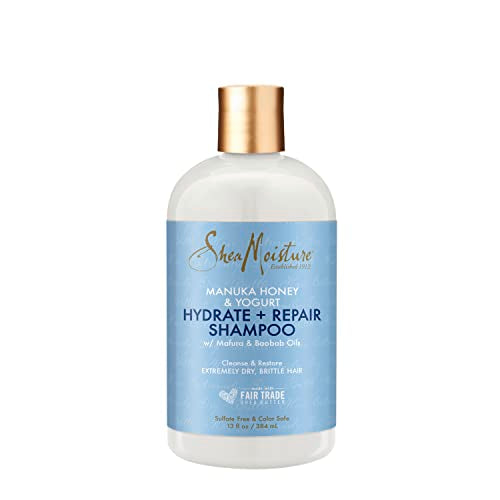
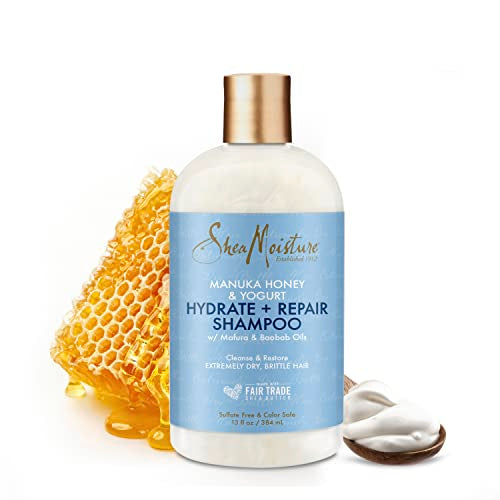
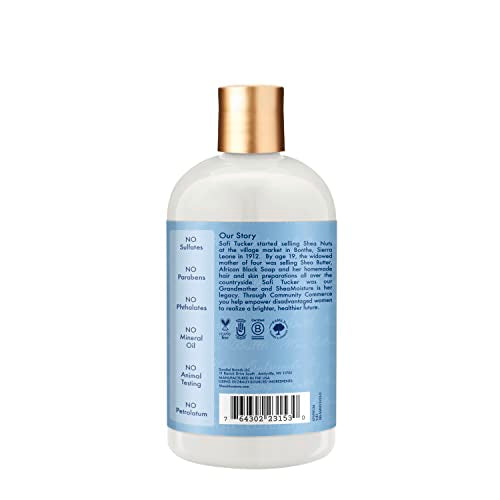
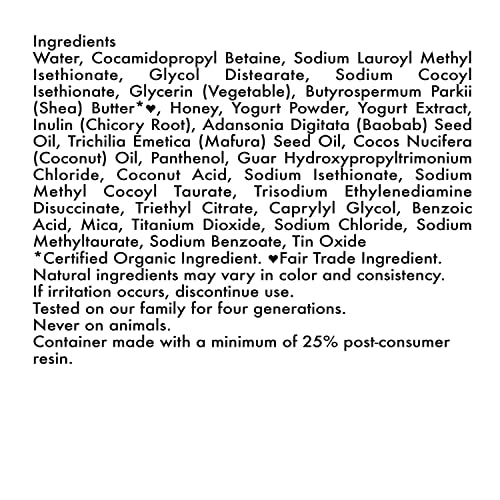
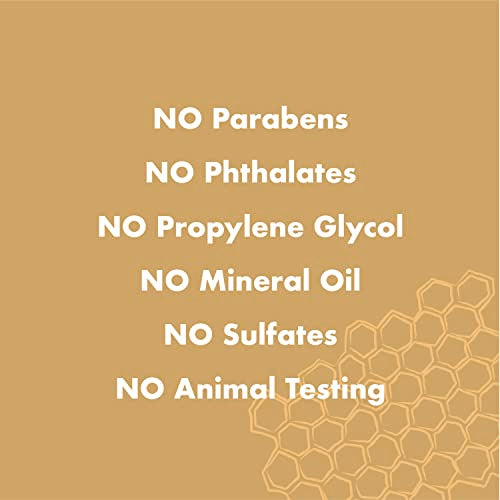
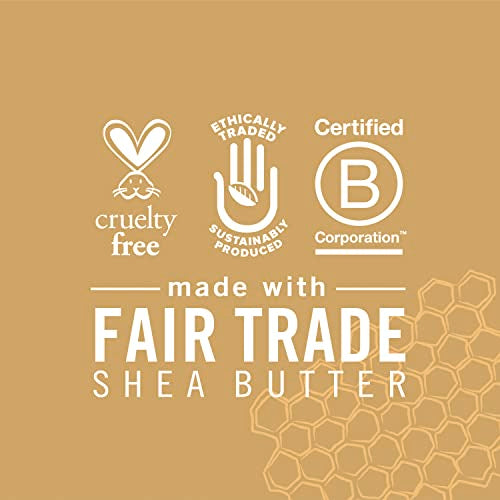
SheaMoisture Shampoo - Restores Moisture & Strength for Damaged Hair with Manuka Honey - 13oz


Fragrance
High RiskFragrance refers to a mixture of aromatic compounds used in products to provide scent. It is commonly listed as 'fragrance' or 'parfum' on product labels and can serve various functions, including enhancing user experience and masking undesirable odors.
Sustai Insights
Fragrance offers functional benefits by improving product appeal; however, it poses significant health risks, notably a high likelihood of causing allergies and allergic contact dermatitis. Environmental risks include potential pollution and endocrine disruption, though its overall carcinogenicity is low. Regulatory bodies have noted concerns regarding its use, leading to a high-risk classification. Safe usage practices should be observed, and alternatives such as natural essential oils are recommended for those sensitive to synthetic fragrances.
Cocamidopropyl Betaine
High RiskCocamidopropyl betaine is a synthetic surfactant derived from coconut oil, commonly used in personal care products for its mild cleansing and foaming properties. It functions as a surfactant, emulsifier, and thickening agent, contributing to the texture and performance of formulations.
Sustai Insights
Cocamidopropyl betaine offers functional benefits as a gentle surfactant, enhancing product foaming and texture. However, it may pose low to moderate allergenic risks and is subject to high use restrictions due to contamination concerns. Regulatory bodies have advised on its safe levels of usage, categorizing its risk level as high overall. Users should practice caution, particularly with sensitive populations, and consider alternatives like naturally derived surfactants for safer formulations.
Glycerin
Medium RiskGlycerin (also called glycerol) is a naturally occurring compound commonly used in personal care and cosmetic products. It functions as a humectant, attracting moisture to the skin, and is also utilized as a solvent and emollient to enhance product texture and stability.
Sustai Insights
Glycerin is valued for its effective moisturizing properties and biodegradability, making it a widely accepted ingredient in formulations. It poses low health risks, including low concerns for carcinogenicity and allergies. However, moderate use restrictions exist due to regulatory guidelines. While glycerin does not significantly contribute to environmental pollution, its production process should be ethically sourced. Overall, glycerin holds a medium risk level, emphasizing the importance of safe usage practices and considering sustainable alternatives.
Citric Acid
Medium RiskCitric acid is an alpha hydroxy acid used in personal care products primarily for its role as a pH adjuster and natural preservative. It occurs naturally in citrus fruits and is commonly utilized in various formulations for its chelating properties and mild exfoliation benefits.
Sustai Insights
Citric acid offers functional benefits as an effective preservative and pH stabilizer, contributing to product longevity and stability. It is biodegradable and derived from renewable sources. Health risks are low, with minimal concerns regarding carcinogenicity, allergies, and reproductive toxicity. However, moderate use restrictions exist due to potential irritation at high concentrations. Environmental risks are limited, as citric acid is not known to accumulate in ecosystems. Regulatory agencies have no significant advisories against its use. Overall, it is assessed as a medium-risk ingredient, with safe usage practices recommended and alternatives available.
Sodium Benzoate
Medium RiskSodium benzoate is a preservative commonly used in food and cosmetic products to prevent microbial growth and extend shelf life. It is derived from benzoic acid and is effective at low concentrations, often used in acidic environments like beverages and condiments.
Sustai Insights
Sodium benzoate serves effectively as a preservative, contributing to product stability and safety. It is generally recognized as safe with low concerns for carcinogenicity, allergies, and reproductive toxicity, though it faces moderate use restrictions in some regions. Environmental risks include its potential as a pollutant, but it does not bioaccumulate significantly. Regulatory bodies have issued advisories regarding its concentration in products. Overall, the risk level is assessed as medium, with safe usage practices recommended. Alternatives such as potassium sorbate may provide similar benefits with potentially lower restrictions.
Potassium Sorbate
Medium RiskPotassium sorbate is a potassium salt of sorbic acid, primarily used as a preservative in food and cosmetic products. It inhibits the growth of molds, yeast, and some bacteria, extending the shelf life of products. It is commonly found in various formulations due to its effectiveness and low toxicity.
Sustai Insights
Potassium sorbate serves as an effective preservative, preventing microbial growth in food and cosmetic products, which is vital for safety and longevity. Although it has a low risk of carcinogenicity and developmental toxicity, there is a moderate concern regarding allergies and immunotoxicity. Environmentally, it poses minimal risks as it is not significantly bioaccumulative. Regulatory agencies have verified its use, although some products may face restrictions. Overall, it is assessed as a medium risk ingredient, with safe usage practices recommended, and alternatives such as natural preservatives could be considered.
Honey
Low RiskHoney is a saccharic secretion gathered and stored by honeybees, primarily composed of sugars such as fructose and glucose. It is commonly used in cosmetic products for its humectant properties, helping to retain moisture and improve skin hydration.
Sustai Insights
Honey offers functional benefits such as moisturizing and soothing properties, contributing to skin care formulations. It has a low risk of health concerns, including potential allergenic reactions and endocrine disruption. Environmentally, honey is generally sustainable, being biodegradable and often sourced ethically. Regulatory bodies place low restrictions on its use, but it should be avoided by individuals with bee allergies. Overall, the ingredient presents a low risk profile for consumers.
Yogurt Powder
Low RiskYogurt powder is a powder obtained from yogurt, primarily used as a flavoring agent and source of nutrients in various food and cosmetic products. It retains the beneficial properties of yogurt, such as probiotics and proteins, and is often utilized for its creamy texture and taste enhancement.
Sustai Insights
Yogurt powder offers functional benefits, such as enhancing flavor and providing nutritional value, including probiotics and proteins. It is generally recognized as safe with low health risks, including negligible concerns for carcinogenicity, allergies, or reproductive toxicity. Environmental impact is minimal, with no significant pollutant potential. Regulatory bodies have not issued restrictions on its use, indicating a low-risk profile overall. Safe usage practices include moderation in consumption, and while alternatives exist, yogurt powder remains a sustainable choice for flavoring and nutrient supplementation.
Sodium Phytate
Low RiskSodium phytate is a complex sodium salt of phytic acid, primarily used in cosmetic formulations as a chelating agent. It helps to stabilize formulations by binding metal ions, which can improve product efficacy and shelf life.
Sustai Insights
Sodium phytate offers functional benefits by enhancing product stability and is considered to have low health risks, with no significant associations with carcinogenicity, allergies, or reproductive toxicity. Environmentally, it poses minimal risks, as it is not considered a pollutant or bioaccumulative. Regulatory status indicates no significant restrictions. Overall, the ingredient is assessed as low risk. However, users should practice safe usage and consider alternatives like other chelating agents if desired.
Sodium Methyl Cocoyl Taurate
Low RiskSodium methyl cocoyl taurate is a sodium salt derived from coconut fatty acids, primarily used as a mild surfactant and foaming agent in personal care products. It helps to cleanse and stabilize formulations, contributing to improved texture and performance.
Sustai Insights
Sodium methyl cocoyl taurate is recognized for its effective surfactant properties, providing gentle cleansing and foam production in formulations. It is considered low risk for health concerns such as carcinogenicity and allergenic potential, with minimal irritation noted. Environmentally, it poses low hazards with no significant bioaccumulation or pollution risks. Regulatory bodies, including ECHA, indicate no current restrictions. Overall, it presents a low risk profile, making it a viable choice in personal care applications. Safe usage practices are recommended, and alternatives may include other mild surfactants.
Glycol Distearate
Low RiskGlycol distearate is a compound derived from stearic acid and ethylene glycol, primarily used as an emulsifier and thickening agent in cosmetic formulations. It helps to stabilize emulsions and improve the texture of products, allowing for better application and consistency.
Sustai Insights
Glycol distearate offers functional benefits as an effective emulsifier, enhancing product stability and texture. It is generally regarded as safe, with low concerns regarding carcinogenicity, allergies, and reproductive toxicity. However, attention is warranted regarding cumulative exposure from multiple sources. While it poses minimal health and environmental risks, users should adhere to recommended usage levels. Overall, the risk level is assessed as low, with no significant regulatory warnings or restrictions.
Polyquaternium 10
Low RiskPolyquaternium-10 is a synthetic polymer used primarily as a conditioning agent in cosmetic products. It enhances the texture and feel of hair and skin, providing moisture retention and improved manageability. This ingredient is known for its film-forming properties, which can help reduce frizz and static.
Sustai Insights
Polyquaternium-10 offers functional benefits in enhancing moisture retention and improving product texture. It is considered to have low health risks, with minimal concerns regarding carcinogenicity, allergenic potential, and neurotoxicity. Environmentally, it poses low ecotoxicity and is not known to bioaccumulate. Regulatory assessments indicate no significant restrictions, categorizing it as low risk overall. For safe use, it is recommended to follow product guidelines. Alternatives include natural conditioning agents like guar gum or xanthan gum for those seeking plant-based options.
Adansonia Digitata Seed Oil
Low RiskAdansonia digitata seed oil is an oil expressed from the seeds of the baobab tree, primarily used in cosmetic formulations for its emollient properties. It is known for its moisturizing capabilities and is often included in skin care products to enhance texture and hydration.
Sustai Insights
Adansonia digitata seed oil offers functional benefits as an effective emollient and moisturizer, contributing to product texture and skin hydration. It is sustainably sourced, with low concerns regarding carcinogenicity, allergies, or reproductive toxicity. Environmental risks are minimal, and it has no current regulatory restrictions. Overall, the ingredient poses low health and environmental risks, making it a suitable option for cosmetic use.
Trichilia Emetica Seed Butter
Low RiskTrichilia emetica seed butter is derived from the seeds of the Trichilia emetica tree, commonly known as the poison wood tree. It is primarily used as a moisturizer and emollient in cosmetic formulations due to its fatty acid content, which provides hydration and enhances skin texture.
Sustai Insights
Trichilia emetica seed butter offers functional benefits as a skin emollient, contributing to moisture retention and improved skin feel. It is sustainably sourced and biodegradable. Health impact assessments indicate low concerns regarding carcinogenicity, allergies, and reproductive toxicity. Environmental evaluations reflect low pollutant potential and bioaccumulation risks. Regulatory status shows no current restrictions. Overall, the ingredient poses low risk, making it a suitable option in cosmetic products.
Sodium Lauroyl Isethionate
Low RiskSodium lauroyl isethionate is a sodium salt of lauroyl isethionic acid, primarily used as a surfactant and cleansing agent in cosmetic formulations. It is known for its mildness and ability to create a rich lather, making it popular in products like shampoos and body washes.
Sustai Insights
Sodium lauroyl isethionate functions effectively as a surfactant, providing cleansing properties while being mild on the skin. It is not associated with significant health risks such as carcinogenicity or high allergenic potential, maintaining a low risk profile. Environmentally, it has minimal pollutant potential and is not known to bioaccumulate. Regulatory bodies have not issued significant warnings regarding its use. Overall, it is considered a low-risk ingredient, suitable for various cosmetic applications.
Sodium Isethionate
Low RiskSodium isethionate is an organic salt commonly used in cosmetic formulations as a surfactant and cleansing agent. It aids in the removal of dirt and oil from the skin, enhancing the overall efficacy of personal care products such as shampoos and body washes.
Sustai Insights
Sodium isethionate offers functional benefits as a mild surfactant, making it effective in cleansing formulations while minimizing irritation. It is considered to have low health risks, with no significant concerns regarding carcinogenicity, allergies, or reproductive toxicity. Environmentally, it poses minimal risks, being non-bioaccumulative and not a major pollutant. Regulatory assessments indicate it’s approved in multiple regions with few restrictions. Usage should be aligned with recommended concentrations to ensure safety. Overall, sodium isethionate is classified as a low-risk ingredient, with no notable adverse effects.
Water
Low RiskWater is a clear, colorless liquid essential for various biological processes. It serves as a solvent in formulations, facilitating the dissolution of other ingredients and enhancing product texture and application. Additionally, water plays a crucial role in hydration and is a key component in many cosmetic and personal care products.
Sustai Insights
Water is an effective solvent and hydrator, contributing to the texture and efficacy of formulations. It is biodegradable and generally regarded as safe, with low concerns regarding carcinogenicity, allergies, and reproductive toxicity. However, excessive water usage can lead to environmental concerns, particularly regarding resource depletion. Regulatory bodies do not impose restrictions on water use in cosmetics. Overall, the risks associated with water are low, making it a safe and essential ingredient.
Panthenol
Low RiskPanthenol, a derivative of vitamin B5, is commonly used in cosmetic formulations for its moisturizing and skin-conditioning properties. It acts as a humectant, helping to retain moisture in the skin and hair, thereby improving hydration and texture.
Sustai Insights
Panthenol offers functional benefits such as effective hydration and skin conditioning, making it valuable in various cosmetic products. It is considered low risk regarding health impacts, with minimal concerns about carcinogenicity, allergies, or reproductive toxicity. Environmental risks are also low, with no significant pollutant or bioaccumulation potential. Regulatory bodies have not imposed restrictions on its use. Safe usage practices include adhering to recommended concentrations. Alternatives like glycerin may provide similar moisturizing benefits, but overall, panthenol is assessed as a low-risk ingredient.
Sodium Chloride
Low RiskSodium chloride is an inorganic salt commonly known as table salt. It is primarily used in food preservation and flavor enhancement, as well as in various industrial applications. It exists as a crystalline solid and dissolves easily in water, making it effective for diverse uses in food products and other formulations.
Sustai Insights
Sodium chloride serves essential functions in food preservation and flavor enhancement. It is considered safe with low health risks related to cancer, allergies, and reproductive toxicity. Environmental concerns are minimal, as it does not bioaccumulate and poses low pollutant potential. Regulatory bodies, including the FDA, recognize its safety for consumption. Overall, sodium chloride carries a low risk profile, making it a widely accepted ingredient in food and cosmetic products.
Cocos Nucifera (Coconut) Oil
Low RiskCocos Nucifera (Coconut) Oil is derived from the kernels of the coconut palm. It is primarily used in cosmetic formulations for its emollient and moisturizing properties, making it suitable for skin and hair care products.
Sustai Insights
Coconut oil serves as an effective moisturizer and emollient, promoting skin hydration and softness. It is sustainably sourced and biodegradable. Health risks are minimal, with low concerns regarding carcinogenicity, allergens, and reproductive toxicity. Environmental impact is also low, as it does not contribute significantly to pollution or bioaccumulation. Regulatory bodies have not issued restrictions on its use. Overall, coconut oil presents a low risk for health and environmental concerns, making it a safe ingredient in cosmetic products.
Butyrospermum Parkii (Shea) Butter
Low RiskButyrospermum parkii (shea) butter is a vegetable fat derived from the nuts of the shea tree. It is commonly used in cosmetic formulations for its emollient properties, providing moisture and improving skin texture. Additionally, shea butter is known for its ability to enhance the stability of products and deliver a creamy texture.
Sustai Insights
Shea butter offers functional benefits as an effective moisturizer, enhancing skin barrier function and texture. It is sustainably sourced and biodegradable, contributing to eco-friendliness. Health-wise, it is associated with low risks for carcinogenicity, allergies, and reproductive toxicity. Environmental impacts are minimal, with no significant pollutant potential identified. Regulatory assessments indicate no current restrictions. Overall, the ingredient presents a low risk, making it a favorable choice in cosmetic formulations.
Honey
Low RiskHoney is a saccharic secretion gathered and stored by honeybees, primarily composed of sugars such as fructose and glucose. It is commonly used in cosmetic products for its humectant properties, helping to retain moisture and improve skin hydration.
Sustai Insights
Honey offers functional benefits such as moisturizing and soothing properties, contributing to skin care formulations. It has a low risk of health concerns, including potential allergenic reactions and endocrine disruption. Environmentally, honey is generally sustainable, being biodegradable and often sourced ethically. Regulatory bodies place low restrictions on its use, but it should be avoided by individuals with bee allergies. Overall, the ingredient presents a low risk profile for consumers.
Yogurt Powder
Low RiskYogurt powder is a powder obtained from yogurt, primarily used as a flavoring agent and source of nutrients in various food and cosmetic products. It retains the beneficial properties of yogurt, such as probiotics and proteins, and is often utilized for its creamy texture and taste enhancement.
Sustai Insights
Yogurt powder offers functional benefits, such as enhancing flavor and providing nutritional value, including probiotics and proteins. It is generally recognized as safe with low health risks, including negligible concerns for carcinogenicity, allergies, or reproductive toxicity. Environmental impact is minimal, with no significant pollutant potential. Regulatory bodies have not issued restrictions on its use, indicating a low-risk profile overall. Safe usage practices include moderation in consumption, and while alternatives exist, yogurt powder remains a sustainable choice for flavoring and nutrient supplementation.
Sodium Phytate
Low RiskSodium phytate is a complex sodium salt of phytic acid, primarily used in cosmetic formulations as a chelating agent. It helps to stabilize formulations by binding metal ions, which can improve product efficacy and shelf life.
Sustai Insights
Sodium phytate offers functional benefits by enhancing product stability and is considered to have low health risks, with no significant associations with carcinogenicity, allergies, or reproductive toxicity. Environmentally, it poses minimal risks, as it is not considered a pollutant or bioaccumulative. Regulatory status indicates no significant restrictions. Overall, the ingredient is assessed as low risk. However, users should practice safe usage and consider alternatives like other chelating agents if desired.
Sodium Methyl Cocoyl Taurate
Low RiskSodium methyl cocoyl taurate is a sodium salt derived from coconut fatty acids, primarily used as a mild surfactant and foaming agent in personal care products. It helps to cleanse and stabilize formulations, contributing to improved texture and performance.
Sustai Insights
Sodium methyl cocoyl taurate is recognized for its effective surfactant properties, providing gentle cleansing and foam production in formulations. It is considered low risk for health concerns such as carcinogenicity and allergenic potential, with minimal irritation noted. Environmentally, it poses low hazards with no significant bioaccumulation or pollution risks. Regulatory bodies, including ECHA, indicate no current restrictions. Overall, it presents a low risk profile, making it a viable choice in personal care applications. Safe usage practices are recommended, and alternatives may include other mild surfactants.
Glycol Distearate
Low RiskGlycol distearate is a compound derived from stearic acid and ethylene glycol, primarily used as an emulsifier and thickening agent in cosmetic formulations. It helps to stabilize emulsions and improve the texture of products, allowing for better application and consistency.
Sustai Insights
Glycol distearate offers functional benefits as an effective emulsifier, enhancing product stability and texture. It is generally regarded as safe, with low concerns regarding carcinogenicity, allergies, and reproductive toxicity. However, attention is warranted regarding cumulative exposure from multiple sources. While it poses minimal health and environmental risks, users should adhere to recommended usage levels. Overall, the risk level is assessed as low, with no significant regulatory warnings or restrictions.
Polyquaternium 10
Low RiskPolyquaternium-10 is a synthetic polymer used primarily as a conditioning agent in cosmetic products. It enhances the texture and feel of hair and skin, providing moisture retention and improved manageability. This ingredient is known for its film-forming properties, which can help reduce frizz and static.
Sustai Insights
Polyquaternium-10 offers functional benefits in enhancing moisture retention and improving product texture. It is considered to have low health risks, with minimal concerns regarding carcinogenicity, allergenic potential, and neurotoxicity. Environmentally, it poses low ecotoxicity and is not known to bioaccumulate. Regulatory assessments indicate no significant restrictions, categorizing it as low risk overall. For safe use, it is recommended to follow product guidelines. Alternatives include natural conditioning agents like guar gum or xanthan gum for those seeking plant-based options.
Adansonia Digitata Seed Oil
Low RiskAdansonia digitata seed oil is an oil expressed from the seeds of the baobab tree, primarily used in cosmetic formulations for its emollient properties. It is known for its moisturizing capabilities and is often included in skin care products to enhance texture and hydration.
Sustai Insights
Adansonia digitata seed oil offers functional benefits as an effective emollient and moisturizer, contributing to product texture and skin hydration. It is sustainably sourced, with low concerns regarding carcinogenicity, allergies, or reproductive toxicity. Environmental risks are minimal, and it has no current regulatory restrictions. Overall, the ingredient poses low health and environmental risks, making it a suitable option for cosmetic use.
Trichilia Emetica Seed Butter
Low RiskTrichilia emetica seed butter is derived from the seeds of the Trichilia emetica tree, commonly known as the poison wood tree. It is primarily used as a moisturizer and emollient in cosmetic formulations due to its fatty acid content, which provides hydration and enhances skin texture.
Sustai Insights
Trichilia emetica seed butter offers functional benefits as a skin emollient, contributing to moisture retention and improved skin feel. It is sustainably sourced and biodegradable. Health impact assessments indicate low concerns regarding carcinogenicity, allergies, and reproductive toxicity. Environmental evaluations reflect low pollutant potential and bioaccumulation risks. Regulatory status shows no current restrictions. Overall, the ingredient poses low risk, making it a suitable option in cosmetic products.
Sodium Lauroyl Isethionate
Low RiskSodium lauroyl isethionate is a sodium salt of lauroyl isethionic acid, primarily used as a surfactant and cleansing agent in cosmetic formulations. It is known for its mildness and ability to create a rich lather, making it popular in products like shampoos and body washes.
Sustai Insights
Sodium lauroyl isethionate functions effectively as a surfactant, providing cleansing properties while being mild on the skin. It is not associated with significant health risks such as carcinogenicity or high allergenic potential, maintaining a low risk profile. Environmentally, it has minimal pollutant potential and is not known to bioaccumulate. Regulatory bodies have not issued significant warnings regarding its use. Overall, it is considered a low-risk ingredient, suitable for various cosmetic applications.
Sodium Isethionate
Low RiskSodium isethionate is an organic salt commonly used in cosmetic formulations as a surfactant and cleansing agent. It aids in the removal of dirt and oil from the skin, enhancing the overall efficacy of personal care products such as shampoos and body washes.
Sustai Insights
Sodium isethionate offers functional benefits as a mild surfactant, making it effective in cleansing formulations while minimizing irritation. It is considered to have low health risks, with no significant concerns regarding carcinogenicity, allergies, or reproductive toxicity. Environmentally, it poses minimal risks, being non-bioaccumulative and not a major pollutant. Regulatory assessments indicate it’s approved in multiple regions with few restrictions. Usage should be aligned with recommended concentrations to ensure safety. Overall, sodium isethionate is classified as a low-risk ingredient, with no notable adverse effects.
Water
Low RiskWater is a clear, colorless liquid essential for various biological processes. It serves as a solvent in formulations, facilitating the dissolution of other ingredients and enhancing product texture and application. Additionally, water plays a crucial role in hydration and is a key component in many cosmetic and personal care products.
Sustai Insights
Water is an effective solvent and hydrator, contributing to the texture and efficacy of formulations. It is biodegradable and generally regarded as safe, with low concerns regarding carcinogenicity, allergies, and reproductive toxicity. However, excessive water usage can lead to environmental concerns, particularly regarding resource depletion. Regulatory bodies do not impose restrictions on water use in cosmetics. Overall, the risks associated with water are low, making it a safe and essential ingredient.
Glycerin
Medium RiskGlycerin (also called glycerol) is a naturally occurring compound commonly used in personal care and cosmetic products. It functions as a humectant, attracting moisture to the skin, and is also utilized as a solvent and emollient to enhance product texture and stability.
Sustai Insights
Glycerin is valued for its effective moisturizing properties and biodegradability, making it a widely accepted ingredient in formulations. It poses low health risks, including low concerns for carcinogenicity and allergies. However, moderate use restrictions exist due to regulatory guidelines. While glycerin does not significantly contribute to environmental pollution, its production process should be ethically sourced. Overall, glycerin holds a medium risk level, emphasizing the importance of safe usage practices and considering sustainable alternatives.
Fragrance
High RiskFragrance refers to a mixture of aromatic compounds used in products to provide scent. It is commonly listed as 'fragrance' or 'parfum' on product labels and can serve various functions, including enhancing user experience and masking undesirable odors.
Sustai Insights
Fragrance offers functional benefits by improving product appeal; however, it poses significant health risks, notably a high likelihood of causing allergies and allergic contact dermatitis. Environmental risks include potential pollution and endocrine disruption, though its overall carcinogenicity is low. Regulatory bodies have noted concerns regarding its use, leading to a high-risk classification. Safe usage practices should be observed, and alternatives such as natural essential oils are recommended for those sensitive to synthetic fragrances.
Panthenol
Low RiskPanthenol, a derivative of vitamin B5, is commonly used in cosmetic formulations for its moisturizing and skin-conditioning properties. It acts as a humectant, helping to retain moisture in the skin and hair, thereby improving hydration and texture.
Sustai Insights
Panthenol offers functional benefits such as effective hydration and skin conditioning, making it valuable in various cosmetic products. It is considered low risk regarding health impacts, with minimal concerns about carcinogenicity, allergies, or reproductive toxicity. Environmental risks are also low, with no significant pollutant or bioaccumulation potential. Regulatory bodies have not imposed restrictions on its use. Safe usage practices include adhering to recommended concentrations. Alternatives like glycerin may provide similar moisturizing benefits, but overall, panthenol is assessed as a low-risk ingredient.
Citric Acid
Medium RiskCitric acid is an alpha hydroxy acid used in personal care products primarily for its role as a pH adjuster and natural preservative. It occurs naturally in citrus fruits and is commonly utilized in various formulations for its chelating properties and mild exfoliation benefits.
Sustai Insights
Citric acid offers functional benefits as an effective preservative and pH stabilizer, contributing to product longevity and stability. It is biodegradable and derived from renewable sources. Health risks are low, with minimal concerns regarding carcinogenicity, allergies, and reproductive toxicity. However, moderate use restrictions exist due to potential irritation at high concentrations. Environmental risks are limited, as citric acid is not known to accumulate in ecosystems. Regulatory agencies have no significant advisories against its use. Overall, it is assessed as a medium-risk ingredient, with safe usage practices recommended and alternatives available.
Sodium Benzoate
Medium RiskSodium benzoate is a preservative commonly used in food and cosmetic products to prevent microbial growth and extend shelf life. It is derived from benzoic acid and is effective at low concentrations, often used in acidic environments like beverages and condiments.
Sustai Insights
Sodium benzoate serves effectively as a preservative, contributing to product stability and safety. It is generally recognized as safe with low concerns for carcinogenicity, allergies, and reproductive toxicity, though it faces moderate use restrictions in some regions. Environmental risks include its potential as a pollutant, but it does not bioaccumulate significantly. Regulatory bodies have issued advisories regarding its concentration in products. Overall, the risk level is assessed as medium, with safe usage practices recommended. Alternatives such as potassium sorbate may provide similar benefits with potentially lower restrictions.
Sodium Chloride
Low RiskSodium chloride is an inorganic salt commonly known as table salt. It is primarily used in food preservation and flavor enhancement, as well as in various industrial applications. It exists as a crystalline solid and dissolves easily in water, making it effective for diverse uses in food products and other formulations.
Sustai Insights
Sodium chloride serves essential functions in food preservation and flavor enhancement. It is considered safe with low health risks related to cancer, allergies, and reproductive toxicity. Environmental concerns are minimal, as it does not bioaccumulate and poses low pollutant potential. Regulatory bodies, including the FDA, recognize its safety for consumption. Overall, sodium chloride carries a low risk profile, making it a widely accepted ingredient in food and cosmetic products.
Potassium Sorbate
Medium RiskPotassium sorbate is a potassium salt of sorbic acid, primarily used as a preservative in food and cosmetic products. It inhibits the growth of molds, yeast, and some bacteria, extending the shelf life of products. It is commonly found in various formulations due to its effectiveness and low toxicity.
Sustai Insights
Potassium sorbate serves as an effective preservative, preventing microbial growth in food and cosmetic products, which is vital for safety and longevity. Although it has a low risk of carcinogenicity and developmental toxicity, there is a moderate concern regarding allergies and immunotoxicity. Environmentally, it poses minimal risks as it is not significantly bioaccumulative. Regulatory agencies have verified its use, although some products may face restrictions. Overall, it is assessed as a medium risk ingredient, with safe usage practices recommended, and alternatives such as natural preservatives could be considered.
Cocamidopropyl Betaine
High RiskCocamidopropyl betaine is a synthetic surfactant derived from coconut oil, commonly used in personal care products for its mild cleansing and foaming properties. It functions as a surfactant, emulsifier, and thickening agent, contributing to the texture and performance of formulations.
Sustai Insights
Cocamidopropyl betaine offers functional benefits as a gentle surfactant, enhancing product foaming and texture. However, it may pose low to moderate allergenic risks and is subject to high use restrictions due to contamination concerns. Regulatory bodies have advised on its safe levels of usage, categorizing its risk level as high overall. Users should practice caution, particularly with sensitive populations, and consider alternatives like naturally derived surfactants for safer formulations.
Cocos Nucifera (Coconut) Oil
Low RiskCocos Nucifera (Coconut) Oil is derived from the kernels of the coconut palm. It is primarily used in cosmetic formulations for its emollient and moisturizing properties, making it suitable for skin and hair care products.
Sustai Insights
Coconut oil serves as an effective moisturizer and emollient, promoting skin hydration and softness. It is sustainably sourced and biodegradable. Health risks are minimal, with low concerns regarding carcinogenicity, allergens, and reproductive toxicity. Environmental impact is also low, as it does not contribute significantly to pollution or bioaccumulation. Regulatory bodies have not issued restrictions on its use. Overall, coconut oil presents a low risk for health and environmental concerns, making it a safe ingredient in cosmetic products.
Butyrospermum Parkii (Shea) Butter
Low RiskButyrospermum parkii (shea) butter is a vegetable fat derived from the nuts of the shea tree. It is commonly used in cosmetic formulations for its emollient properties, providing moisture and improving skin texture. Additionally, shea butter is known for its ability to enhance the stability of products and deliver a creamy texture.
Sustai Insights
Shea butter offers functional benefits as an effective moisturizer, enhancing skin barrier function and texture. It is sustainably sourced and biodegradable, contributing to eco-friendliness. Health-wise, it is associated with low risks for carcinogenicity, allergies, and reproductive toxicity. Environmental impacts are minimal, with no significant pollutant potential identified. Regulatory assessments indicate no current restrictions. Overall, the ingredient presents a low risk, making it a favorable choice in cosmetic formulations.
Revitalize your hair with SheaMoisture's Hydrate and Repair Shampoo, specially formulated for damaged hair. This sulfate-free shampoo harnesses the power of Manuka Honey and Shea Butter to cleanse and nourish, leaving your hair strong and shiny.
- Moisture Restoration: Infused with Manuka Honey and yogurt extract, this shampoo replenishes moisture in dry, brittle strands, promoting a healthy shine.
- Gentle Cleansing: Sulfate-free formula effectively cleanses without stripping essential oils, making it ideal for delicate hair types.
- Nutrient-Rich Ingredients: Contains Fair Trade shea butter and Mafura oil, known for their hydrating and conditioning properties, ensuring your hair feels soft and manageable.
- Cruelty-Free Assurance: Tested on family for generations and never on animals, aligning with ethical and sustainable practices.
- Versatile Hair Care: Suitable for all hair types, this shampoo can be used as a daily cleanser or a moisturizing treatment, enhancing your hair care routine.
Embrace healthier hair with every wash, knowing you’re supporting sustainable practices.
Subscribe & Save with Sustai
- Best Price Guarantee: Always enjoy the lowest prices on sustainable home essentials.
- No Surprises: We’ll notify you before shipping. No hidden fees, ever.
- You’re in Charge: Change, pause, or cancel your subscription anytime with ease.
- Eco-Friendly Deliveries: Our grouped shipments mean less packaging and lower emissions.
Join us on a sustainable journey. Special offers for a limited time! Prices and promotions may change.
Recommended Products
Revitalize your hair with SheaMoisture's Hydrate and Repair Shampoo, specially formulated for damaged hair. This sulfate-free shampoo harnesses the power of Manuka Honey and Shea Butter to cleanse and nourish, leaving your hair strong and shiny.
- Moisture Restoration: Infused with Manuka Honey and yogurt extract, this shampoo replenishes moisture in dry, brittle strands, promoting a healthy shine.
- Gentle Cleansing: Sulfate-free formula effectively cleanses without stripping essential oils, making it ideal for delicate hair types.
- Nutrient-Rich Ingredients: Contains Fair Trade shea butter and Mafura oil, known for their hydrating and conditioning properties, ensuring your hair feels soft and manageable.
- Cruelty-Free Assurance: Tested on family for generations and never on animals, aligning with ethical and sustainable practices.
- Versatile Hair Care: Suitable for all hair types, this shampoo can be used as a daily cleanser or a moisturizing treatment, enhancing your hair care routine.
Embrace healthier hair with every wash, knowing you’re supporting sustainable practices.

You can have at most 2 Sustainable Steals products in your cart
Customer Reviews
Customers’ View
Customers appreciate the effectiveness and natural formulation of SheaMoisture's Hydrate and Repair Shampoo. Many highlight the pleasant scent and the soft, shiny results it provides, with phrases like "my hair felt softer even wet" and "it makes my hair soft and glossy" reflecting their satisfaction. Users value the shampoo's ability to cleanse without stripping natural oils, noting it lathers well and rinses easily. However, there are mixed reviews regarding moisture levels, with some finding it hydrating while others experienced dryness or greasiness. Overall, this product resonates with environmentally and health-conscious consumers due to its sulfate-free and cruelty-free formulation, aligning with their values for ethical and safe personal care. Customers generally find it to be a reliable addition to their hair care routine.
AI-generated from the text of customer reviewsThis product is rated 4.7 of 5.0 stars.
It has received 18 reviews.




